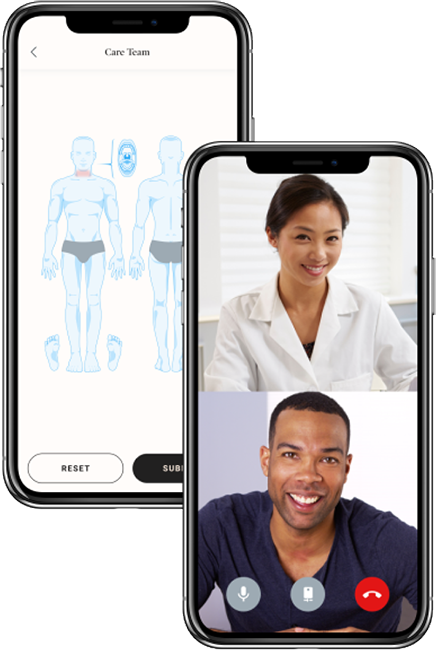Telemedicine
for Canadian
HR Leaders
Everything you need to know about how virtual care can benefit your employees and your organization.
Improve the overall health and wellness of your organization with a single, modern platform.
We drive real member outcomes through virtual care and Humanized Healthcare.
Improve productivity, reduce absenteeism, and build a culture of happiness and well-being.
Essential wellness services to stay happy and healthy, in one digital-first platform.
Flexible, integrated, and personalized mental health care, backed by science.
A complete member journey accessible from our industry-leading virtual care platform.
Empower all of your members to proactively adopt healthy habits.
High-quality, virtual benefits for your employees aren’t an expense - but an investment
Explore the positive impact of Dialogue's virtual care.
Learn how Dialogue is reinventing the EAP experience.
Dialogue is the leading health and wellness provider in Canada.
Discover the latest news, content and reports for HR leaders.
Learn more about health, organizational well-being, and life at Dialogue!
Learn how we improve the health and wellness of our clients.
 Newsletter
Newsletter
Stay a step ahead on employee benefits, wellness, and productivity news and resources.
Dialogue’s 2024 research is now available. This year, we're diving deep into new topics that truly matter to you.
Save your spot for an insights-packed webinar led by organizational leaders and industry experts.
Learn all about championing mental health for workplace resilience from renowned speakers and industry leaders.
Everything you need to know about how virtual care can benefit your employees and your organization.
Telemedicine is one of the most effective forms of healthcare in Canada and elsewhere around the world, whose popularity particularly skyrocketed during the COVID-19 pandemic. With 70% of issues seen in traditional doctor’s offices and clinics now being able to be conveniently and effectively treated through telemedicine instead, this innovative form of healthcare is more popular now than ever before – and this is just the beginning.
Corporate wellness initiatives have gradually become expected by the multigenerational workforce. But as companies continue to adapt to new normals, it’s clear that purchasing a ping-pong table or offering a discount at the gym next door is no longer enough. With a healthy workplace environment more valuable than ever to Canadian workers, top marks go to those organizations with a positive wellness culture. Since health and wellness options can seem endless, however, we've crafted this guide with concrete examples you can implement in your organization. You'll also learn why corporate wellness provides benefits to employees and employers alike, how to ensure your initiatives are successful, and much more.

In fact, more and more employers across Canada have been recognizing the important role that telemedicine can play in attracting and retaining top talent in their organizations while simultaneously saving their company money in the long run through saved disability costs.
But despite its recent rise into mainstream culture, there can still be some confusion around what telemedicine really is. As an HR leader, why is understanding telemedicine beneficial for you? There are plenty of advantages associated with offering your team telemedicine benefits, and we strongly believe that telemedicine should be at the core of any company’s health plan.

Read on to learn how telemedicine works and how it can help you:
But despite unhealthy employees costing big bucks, there's plenty of good news as well: an analysis by Sun Life Financial showed that companies that kick-started an effective wellness program reduced costs and experienced financial gains.
These included:
Corporate wellness programs are a win-win in the workplace world, where healthier employees are happier, happier employees are more productive, and companies stand to benefit from improved financial health.
This is a correlation that’s backed by hard evidence.
Not only does the Sun Life-Ivey Canadian Wellness Return on Investment (ROI) Study show that corporate wellness programs reduce absenteeism2, a 2018 study by the McGill Comprehensive Health Improvement Program found that, after 1 year, the benefits of Canadian corporate wellness programs resulted in clinically important improvements in physical and mental health3.
And it doesn't stop there.
Well-designed workplace health promotion programs can improve blood pressure and cholesterol levels while providing the virtual services Canadian employees are looking for more and more. These elements can in turn impact financial measures important to employers, including health benefits utilization and worker productivity.
But the key word here is "well-designed." You can't just stock your break room with granola bars or host the occasional online social event and call it a day. Wellness programs work when they're tailored to the needs and goals of certain groups and when they provide opportunities based on employee engagement, input, and feedback.
Stepping back and identifying gaps in your current wellness structure can help you develop an agile, equitable, inclusive program designed for the workforce of the future.

Telemedicine (interchangeably referred to as “telemedicine”, “telehealth”, and “virtual care”) is the remote diagnosis and treatment of patients using telecommunications technology. It’s a form of care where the initial consultation doesn’t require physical presence or a physical exam. Remote patient monitoring is another aspect of telehealth, whereas clinicians track a patient’s health through remote testing. Providing your employees with unlimited primary care means that medical and well-being consultations happen when and how they need to, at no cost to your employee. It’s like having a doctor on demand.
A patient’s telemedicine journey typically follows these steps:

A patient opens a telemedicine app on their mobile device or computer. They then answer a series of questions to begin the triage process and guide the member towards the best next step based on their need.
The patient is connected with the appropriate care resource/professional who can provide medical advice.
The patient receives a care plan, prescription, and any required referrals or laboratory tests.
The patient receives a follow-up from the same medical professional (1-7 days later, depending on the diagnosis) to ensure the patient is on the path to remission.
With many telemedicine providers, patients have the option to interact with care professionals through their preferred communication channel (chat, video call, phone call). This gives patients maximum flexibility to meet their needs throughout their day and allows them to proactively take care of their health in whichever way they’re most comfortable with.

A telemedicine provider with a multidisciplinary team (like Dialogue’s) can evaluate a growing number of primary care, mental health, and well-being conditions, including (but not limited to):

While 86% of Canadians report having a family physician, nearly 50% say that it would take over four days to be seen by a healthcare professional. Virtual healthcare doesn’t replace the public healthcare system but rather complements it by making it easier and faster to get access to medical care when a trip to a walk-in clinic isn’t necessary, which enables your employees to take care of their health uncompromisingly and without waiting. This is particularly beneficial for those who live in rural or remote areas or in a bustling city centre. Additionally, with members’ consent, patient health information can be shared across professionals (ex. from a Dialogue MD to a member’s GP), to reduce gaps in the continuity of care.
According to a 2017 survey from the Conference Board of Canada, one-third of Canadian employers have a formal corporate wellness program in place and almost half have informal policies - stats that have jumped significantly since 2009.5
The International Foundation of Employee Benefit Plans also reported in 2017 that 75% of employers offer wellness initiatives to improve overall worker health and well-being. Of those companies that instituted wellness programs, 66% saw an increase in productivity and 67% reported their employees were more satisfied.6
Given that 80% of Canadian employees believe their overall well-being would improve if they were offered a personalized wellness program7, employers are expressing renewed urgency around employee wellbeing and mental health.
Give your employees the care they want and deserve. As it turns out, over 70% of Canadians believe that virtual care represents the future of healthcare and 82% of Canadians believe that telemedicine should be available as an employee benefit. Of course, there are plenty of other concrete benefits for both employers and employees alike.

As an employer, offering your employees fully-rounded healthcare benefits can demonstrate that you value your team’s well-being as well as make your organization a more desired workplace for potential talent prospects. According to the 2020 Sanofi Canada Healthcare survey, 86% of employees agree that a workplace environment that encourages health and wellness is an important factor when deciding on a job offer or when deciding whether or not to remain with a company.
.jpg)
Absenteeism is a prime contributor to lost revenue and productivity for Canadian organizations and the economy as a whole. Employee absenteeism costs employers $16.6 billion annually, at an average annual of $2,000 per employee in Canada. Although not as widely measured, presenteeism (employees who come to work sick or who suffer from conditions that prevent them from working productively) can also have a significant impact on productivity losses. With 60% of employees not engaged at work, it’s crucial for organizations to decrease engagement-related productivity loss.
Telemedicine helps by reducing time spent away from work, as well as minimizing personal and travel time required for in-person consultations. This enhances employee work-life balance and generates greater productivity levels at work.

Mental health is one of the major causes of short- and long-term disability, absenteeism and presenteeism costs. A recent Sanofi Canada Healthcare study reported that:
Left unmanaged and untreated, stress of this magnitude can lead to more serious mental illness issues, such as anxiety and depression. Yet, 1 in 4 people suffering from a mental health issue don’t seek professional help. This is due to stigmatization, limited access to resources, expensive care-related costs, and patients ignoring treatment recommendations.
According to the Mental Health Commission of Canada, $51 billion is lost each year in the Canadian economy due to mental health issues among employees. Employers incur approximately 25% of these costs.
Telemedicine offers new, more promising avenues for treating mental health. Greater accessibility, a multidisciplinary approach, and regular follow-ups mean that telemedicine can offer comprehensive, convenient, and cost-effective mental health care.

Why is telemedicine important? Because it makes it simpler for your employees to improve their health and well-being. It provides convenient, on-demand to online physicians, nurses, and other care and well-being professionals as well as refers patients to a network of online doctors, medical specialists and other healthcare professionals. In Dialogue’s approach, every video consultation is accompanied by a care plan, navigation support, follow-ups, and self-management resources.
Telemedicine and remote patient monitoring can benefit patients by:

Over 80% of millennials – who account for over 50% of today’s workforce – consider work-life balance to be a crucial requirement for where they work. With telemedicine, employees can have prescriptions sent directly to their pharmacy or to their home or workplace, giving them further control over their daily schedules and contributing to a better work-life balance. It also allows employees to seek care outside of work hours or when travelling. With so many employees working remotely, the ability to offer standardized healthcare to all employees, no matter where they are or what time they need it at, is a huge advantage.
.png)
Here are a few key elements to look out for in a telemedicine provider:

Some telemedicine providers (like Dialogue) offer a one-stop-shop approach to virtual care. For example, Dialogue’s Integrated Health Platform (IHP) allows employers to easily add or remove different health and wellness programs – primary care, mental health, and an employee assistance program – to build a cocktail of care benefits that suits their organization’s needs best. Having a fully-integrated platform reduces the frustration of managing multiple benefits programs across different providers, and increases the adoption and utilization of these programs by providing members simplified access.
In addition, multidisciplinary care, focused on meeting the patient’s needs and available on a single platform, has been proven to lead to the best outcomes. A multidisciplinary care team (such as Dialogue’s) is typically composed of the following:

A medical team of general practitioners, nurse practitioners, and nurse clinicians help treat and support a wide range of non-urgent health concerns, such as general health inquiries, skin issues, or minor injuries and traumas. In the case that a member’s issue requires a medical test or an in-person evaluation, this care team provides the necessary referral and helps to find and book the right specialist. Additionally, some providers (like Dialogue) follow-up with patients (even for tests or evaluations done externally) to ensure they’re getting the help they need and are on the path to recovery.

Mental health issues are complex and can vary quite significantly. These teams should be staffed with a variety of mental health professionals including mental health specialists, social workers, occupational therapists, psychotherapists, psychologists, etc., to address a broad scope of issues as well as attend to individual preferences. From self-guided resources for those who prefer more autonomy to a personalized, practitioner-led treatment plan, this team works with a member to ensure they are connected to the right professional to help them quickly get back on their feet. With this multidisciplinary approach, medical practitioners can also do a clinical assessment and provide prescriptions to help manage symptoms if necessary.

To help support patients with non-medical issues, this team also consists of non-clinical specialists such as legal advisors, financial professionals, career counsellors, and trauma specialists. These kinds of professionals are typically available through an employee assistance program (EAP) and provide confidential counselling to members for personal or work-related challenges that may be hindering their productivity and well-being. Additionally, a crisis and trauma support team may be available to provide psychological first aid in cases of critical incidents at the workplace.

Since telemedicine involves the transmission of sensitive personal information, it’s important to reassure members that their data is safe and secure. When it comes to the safety of members and privacy of data protection, telemedicine providers should take all necessary measures to keep client information confidential. In terms of safety member safety, the following best practices should be met:
The best telemedicine providers meet all regulatory requirements in the jurisdictions where your organization operates, and ensure that all third-party vendors are safely managing and storing your data. They should also have earned certification for being SOC2 compliant, which reports internal measures that organizations take to govern the services they provide. A provider’s SOC2 compliance lets you know that your employees’ information is protected against deliberate and accidental threats and vulnerabilities. You can rest assured that your information and data will remain entirely confidential.

Your employees deserve to be treated as safely and effectively as possible. To ensure this and to comply with physician regulating bodies, there are certain rules, regulations and operational processes that telemedicine providers and their care team should follow, including:
It’s important to check with your telemedicine provider that all best practices are being followed. To learn more about these best practices and the questions to ask your provider, click here.

According to a recent study, there are certain top attributes that Canadians want and expect from telemedicine providers, including:
When selecting your telemedicine provider, it’s key to make sure that all of these attributes are included in the provider’s offering. After all, you want to give your employees health benefits that they will actually want to use.

It can be challenging to get employees to embrace health benefits. The key is to create new habits: When they have a health concern, they should come to rely on telemedicine and their “doctor in their pocket.” But how can you achieve this?
In order for HR professionals to effectively communicate a new benefit, it’s important that the telemedicine provider you choose will work with you long-term to build trust in your new telemedicine system. Beyond the initial rollout, your provider should offer a comprehensive awareness campaign, which includes onboarding, ongoing educational resources, follow-ups and evaluations that all act together to increase program adoption rates.

